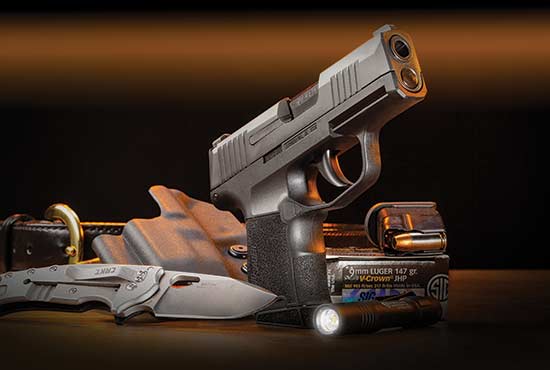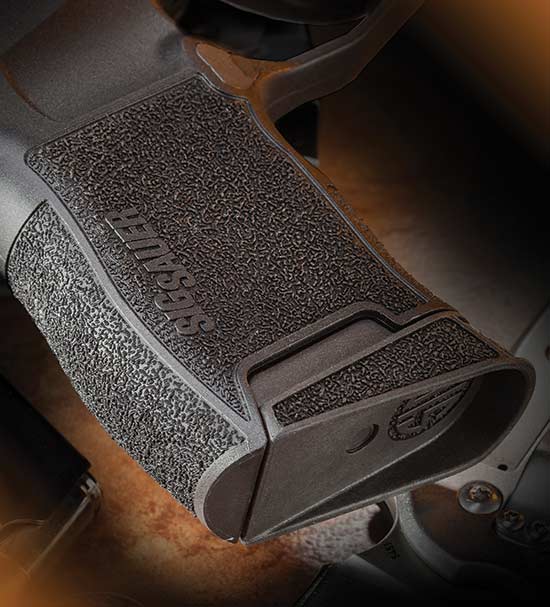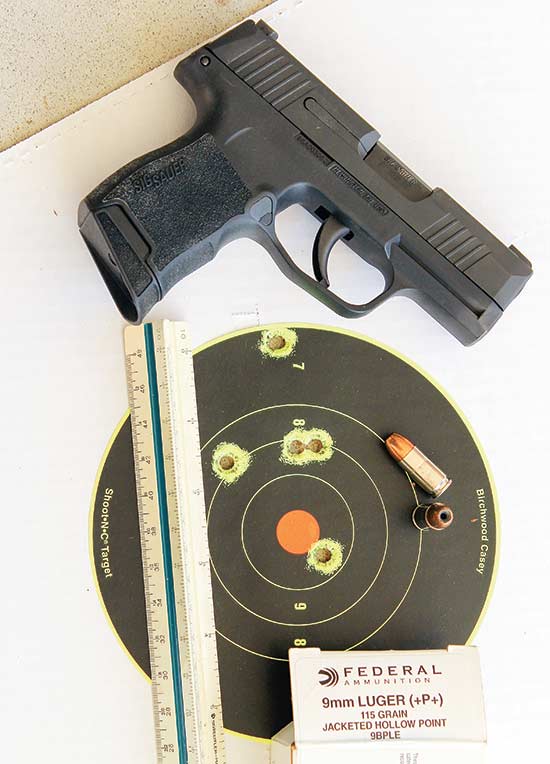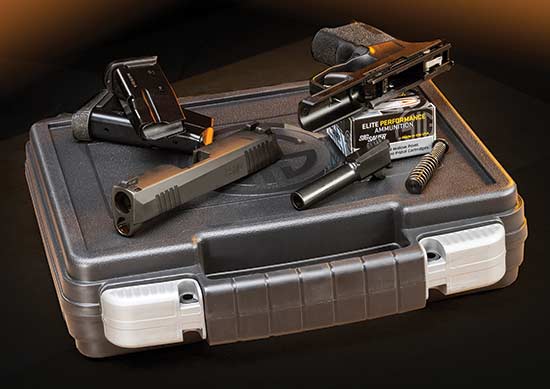SIG New-Niche 9: EDC Champ? Could Be. The P365’s A Slimline Showstopper
10th Aug 2018
Credit: Guns Magazine
By Massad Ayoob
Photos: Rob Jones/The Imagesmith, LLC
Dept. of Ergonomics: Unobtrusive controls for maximum “carryability,” plus grasping grooves for
easier slide racking and a short light/laser rail up front.
Introduced at the 2018 SHOT Show, the SIG P365 emerged as the Hot Item in the CCW niche. The goal was to create a pistol the size of a 7- or 8-shot super-slim pocket 9mm. Something in the S&W Shield, GLOCK 43 or Ruger LC9 category — but with the 11-shot capacity of, say, the GLOCK 26. SIG appears to have succeeded. The new design is generally credited to a team of brilliant SIG engineers, and to Pistol Product Manager Phil Strader.
Striker-fired with a polymer frame, the pistol’s reduced girth comes in part from steel as opposed to polymer magazine bodies (currently produced for SIG by Checkmate), and from an ingenious offset magazine release button riding the curve at the forward edge of the frame. Overall thickness is listed at 1″, length at 5.8″ with a 3.1″ barrel. The unloaded weight is 17.8 oz.
The P365 comes with two 10-round magazines, one flat-bottom for maximum concealment and the other with a flange on the floorplate to provide a resting place for your pinky finger. The slide has grasping grooves up front and, conventionally, in back, and there’s a rail for a small light or laser attachment in front of the triggerguard.
Accessories after the purchase: CRKT Batum folder, Comp-Tac OWB holster, Galco Dress Belt,
Streamlight Protac 2L-X and Micro USB.
Early On
The first shipment of P365s to hit the street had some teething problems. SIG had received a bad batch of SIGLite night sights from a vendor, and there were also scattered reports of failure to go into battery. Phil Strader told us this:
“There were some issues with occasional failure to go into battery. We got guns back, and decided to change some spring weights. That fixed a problem attributed to weaker wrists or grasps. Of just over a thousand guns, less than 4 percent have been returned at this time. We decided to replace the SIGLite sights with our X-Ray3 sights. Anyone with a bad sight, or currently experiencing malfunctions with their early P365, can simply send it back to the factory. If your pistol has the X-Ray3 sights, it means it is later production and is not affected.”
Mas liked the sights of the P365. The rear is dovetailed for windage adjustment
with the aid of a sight pusher.
Testing One, Two . . .
I was actually assigned two articles on this pistol, this one for GUNS of course, and one for FMG’s Concealed Carry Special Edition. The latter’s deadline came up first, encompassing a test team of half a dozen shooters in Florida including myself, and after the article was done I took our test pistol to Arizona and ran it by four more experienced pistol packers. Ten total testers made the math easy: 20 percent female, 20 percent left-handed, most already carrying high-quality 9mms at least part of the time as their every day carry gun.
All (as in 100 percent) gave the trigger pull high marks. It’s essentially two-stage with an easy take-up flowing into a short, smooth roll until the shot breaks. Pull weight on the Lyman digital gauge averaged just under 5.5 lbs. weighed at the toe (where a pivoting trigger like this offers weight-reducing leverage), and about 6.75 lbs. at the center (where we actually apply pressure to the darn thing).
Those X-Ray3 sights were liked by 90 percent of our shooters (one didn’t like the big, green ball of the tritium front sight was so much bigger than the smaller glowing dots at the rear). Most, however, appreciated the verdant circle came so quickly to the eye in the close, fast shooting for which the P365 was designed. Making this sighting arrangement standard was, in my opinion, a very smart move.
Recoil is about the same as a GLOCK 43. Pocket-pistol size equals pocket-pistol recoil with the same caliber. It’s naturally snappier with +P and +P+ ammo. While the P365 is officially rated to handle +P, no gunmaker I know of warrants for +P+, since the industry hasn’t set any real standards for this level. That said, Strader told me the P365 stood up to +P+ in factory testing, and I had no problems with it in that regard.
Dealer’s choice: A flat-bottom 10-round magazine, or a flange-toed one like this to rest your pinky.
The 3.1″ barrel sits above a full-length guide rod with what Mas feels is an unheralded feature —
it allows the barrel/slide assembly to stay in battery when the muzzle is pressed straight in against
resistance. A “hard contact” shot in last-ditch defensive situations can save your life.
Why Not 25?
One test of the P365 I’ve read had the gun rated for accuracy at 15 feet. Gunwriters can cut some slack in this respect for small pocket pistols; fate and reality, however, may not cooperate. So I still test at 25 yards, which is customary for full-size service pistols, where the standard seems to have evolved that “five shots in four inches at 25 yards equals ‘acceptable service pistol accuracy.’”
Given the vast number of police shootings evolve out of some perpetrator originally ravaging a helpless citizen, I kinda like the idea of the citizen being able to solve the problem before the police even get there. Another given: armed citizens carry guns to protect themselves from the same vicious criminals the police carry guns to protect them from. Therefore, it strikes me as a good idea to see how the carry gun of the real first responder (the intended victim) compares to the official first responder (the arriving officer).
I’ve made it a habit to test with the three most popular bullet weights in the given caliber, 9mm of course in this case. The 147-gr. subsonic kicked very softly in the P365, and two loads (SIG FMJ and Remington-UMC) both went just a bit over 4″ for all five shots at 25 yards from a Matrix rest on a concrete bench. This testing format will give you a good idea of what an experienced shooter can expect in perfect, stress-free conditions. I also measure the best three shots in each such group, because exhaustive testing has shown this roughly duplicates what that gun and that load is likely to do from a machine rest. The 147-gr. loads gave three-shot clusters of 1.55″ (Rem-UMC) and 1.60″ (SIG FMJ), which was way more reassuring.
However, in both tests 115- and 124-grain ammo shot tighter than the 147s. Two 115-gr. Federal products, cheap American Eagle FMJ training ammo and the hot 9BPLE +P+ JHP, were tested. The ball round ran pretty close to the 147s in accuracy, but the high speed JHP 115 put all five shots in 3.10″ and the best three in exactly half at 1.55″.
Real magic happened with the 124-gr. “middle weight.” One of the most street-proven 9mm rounds is Speer’s 124 gr. +P Gold Dot, known as “the New York load.” It passed the service pistol test in the tiny SIG P365 with 3.95″ for all five shots at 25 yards, the best three in 1.80″.
And topping the accuracy mark was SIG’s 124-gr. V-Crown JHP which put five shots into 1.5″ at 25 yards. A single .40 slug could have touched all of the best three in the group. For a gun this size, this is simply phenomenal.
Federal 9BPLE 115-gr. +P+ JHP, SIG P365, from 25-yard bench rest. The SIG barked a bit with the hot stuff,
but handled it just fine. Photo: Gail Pepin
The Reliability Factor
I lost exact count early on, but by the time we finished the second test run, we were coming right up on 1,000 rounds without cleaning or adding any lubrication to the gun as it came out of the box. There were no malfunctions of any kind in the first test cycle, and then only two in the second — failures to feed. Both occurred with out-of-spec Winchester “White Box” 115-gr. ball rounds that wouldn’t have fed in any other 9mm either. Hence, the 100 percent reliability rating.
One feature of the P365 — which I’m amazed SIG doesn’t advertise — is its full-length recoil spring guide rod allows the barrel/slide assembly to stay in battery when the muzzle is pressed straight in against resistance — the sometimes necessary “hard contact” shot in last-ditch defensive shooting. More subcompacts than not will go out of battery and fail in that kill-or-be-killed situation. The P365 will let you make this hard contact shot.
Eleven rounds of 9mm on tap equals the capacity of a 5-shot S&W and a 6-shot
Colt snubbie combined. Photo: Gail Pepin
Ergonomics “At Speed”
The P365 would be a very good choice for IDPA BUG or even CCP competition. The International Defensive Pistol Association has divisions for subcompact Back-Up Guns like this one, and it’s shootable enough for the Concealed Carry Pistol division designed for 4″ barreled 15-shot 9mms and the like. I couldn’t find one of those matches that coordinated with the deadlines, so I shot the P365 over four sets of falling plate racks like the event at a GLOCK match.
I also ran an off-duty/backup gun police qualification course going from four to 15 yards on fixed times. The plate runs were in the ballpark with my last couple of GLOCK matches with my familiar G26 subcompact, and the qualifying score was 300 out of 300 possible. I was satisfied with the P365’s performance.
My only personal beefs with the gun are that it pointed low for me (which is of course subjective) and — as received — it shot to the right. We fixed it with a sight tool. Also (objectively) all of the right-handed shooters had difficulty with the mag release.
In moving it to keep the profile slim, the P365’s mag release button angle had to be altered. Imagine you’re having an out-of-body experience and are looking down at yourself from above as you shoot on the range, aiming due north. Normally, to press a release button you would apply pressure due east. On the P365 the pressure has to go inward and rearward, essentially southeast. Our RH shooters found their thumbs didn’t go in that direction. But our southpaws, using their trigger finger which can naturally curve in that direction, said “What’s the problem?”
Fortunately, you can easily swap the mag release button to the other side and shoot it in mirror image like a southpaw, which strikes me as a fine idea.
Field stripping is easy. The P365 comes with two magazines and a sturdy hard case.
Not to mention a very reasonable sticker price.
With the profile of a slim seven-shot “Pocket 9” and the 10-plus-1 capacity of a full-size service pistol in one of the “magazine limit” jurisdictions, the SIG P365 essentially creates a new niche in defensive handguns. It’s a solid value at $599 MSRP, as evidenced by the fact 30 percent of our test team have already bought one after testing, and more have said enthusiastically they intend to do so.











